
Panoramic digital photo mosaic showing Tutuila, American Samoa in the distance.
Photos taken at sea aboard the R/V Roger Revelle by Stassia Samuels, National Park of American Samoa, March 2002

Of major significance has been the establishment in 2001 of an American Samoa GIS User Group (Table 1), which has facilitated management of several of the aforementioned environnmental issues and responsibilities. Led by the American Samoa Government's Department of Commerce and comprised of ~30 representatives from the various government agencies, as well as the American Samoa Community College, the group performs a variety of important digital mapping and spatial analysis tasks, including: inventory and organization of existing data; development of a land information system; wetlands delineation maps for Tutuila; and the use of satellite imagery to update territory base maps.
Table 1. Agencies with interest or current participation in the American Samoa GIS User Group
|
American Samoa Coastal Zone Management Program |
American Samoa Community College |
|
American Samoa Government, Department of Commerce |
American Samoa Government, Department of Marine and
Wildlife Resources |
|
American Samoa Government, Department of Public
Works |
American Samoa Historic Preservation Office |
|
American Samoa Power Authority |
Fagatele Bay National Marine Sanctuary |
|
National Park of American Samoa |
Natural Resources Conservation Service, U.S.
Department of Agriculture, American Samoa |
|
The Nature Conservancy, American Samoa |
U.S. Enviromental Protection Agency, American Samoa |
|
U.S. Fish and Wildlife Service, American Samoa |
U.S. Forest Service, American Samoa |
|
U.S. Geological Survey, American Samoa |
|
The inception of the user group was serendipitously coincident with recent bathymetric surveying around the island, leading further to the establishment of a FBNMS GIS (Wright et al., 2002), as well as renewed interest in the territory by NOAA and the USGS in connection with the pressing need to now to monitor and protect Pacific coral reefs (Anderson, 1999; U.S. Coral Reef Task Force, 2000). In the spirit of "enterprise GIS" (i.e., GIS used by multiple agencies within an organization, or in this case, within a territory), the paper will attempt to review some of the recent developments.
Initial Bathymetric Mapping and a FBNMS GIS
In late 1990s NOAA launched a major intiative to explore, document, and provide critical
scientific data for the National Marine Sanctuary System, with
the goal of developing a strategy for the restoration and conservation of the
nation's marine resources. One of the major catalysts behind this effort has been the
5-year Sustainable Seas Expeditions (SSE;
sustainableseas.noaa.gov),
led by famed marine biologist and National Geographic Explorer-in-
Residence Dr. Sylvia Earle and former National Marine Sanctuary program
director Francesca Cava. SSE has been using new technologies, including
their 1-personed submersible DeepWorker, to pioneer the first explorations
of the sanctuaries. Its mission plan includes three phases: (1) initial photo
documentation of sanctuary plants, animals, and habitats at depths up to
~600 m; (2) expansion on the characterization of habitats, focusing on larger
animals such as whales, sharks, rays, and turtles; and (3) analysis and
interpretation of data, along with extensive public outreach and education.
Logistics and scheduling have prevented a visit to the FBNMS by a NOAA research vessel with the DeepWorker submersible, but the author, as an SSE collaborator, teamed with FBNMS manager Nancy Daschbach, and University of South Florida (USF) scientists David Naar and Brian Donahue, to undertake successful bathymetric surveys and the initiation of a FBNMS GIS in April and May of 2001. Until recently the sanctuary, as well as the national park were largely unexplored below depths of ~30 m, with no prior bathymetric base map in existence and no comprehensive documentation of undersea flora, fauna, and habitat. The team used a Kongsberg-Simrad EM 3000 portable multibeam bathymetric mapping system, attached to the bow of a 30-foot survey boat loaned by the Department of Marine & Wildlife Resources (DMWR) of the America Samoa Government. Further details of the logistics of the survey may be found in Wright et al. (2002).
In 2 weeks of surveying, full bathymetric coverage was obtained around selected sites off the main island of Tutuila, American Samoa: the FBNMS in the southwest, part of the National Park along the north shore, Pago Pago harbor and Taema Bank to the south, and Faga'itua Bay in the southeast (Figure 1). Post-processing steps after the surveys were completed included the "cleaning" of the navigation to delete erroneous positions, then tidal corrections were applied to the depth soundings using NOAA, verified downloaded tide data available for the study area. ASCII formatted x-y-z depth data were then gridded using MB-System, a public-domain suite of software tools for processing and display of swath sonar data. Initial maps made from the grids with Generic Mapping Tools (GMT) revealed many important features such as reef terraces, erosional remnants, volcanic edifices, and blocks of reef debris (e.g., Figure 2). Mapping of the Pago Pago harbor also captured in striking detail the wreckage of the USS Chehalis, a WWII oil and gas tanker that exploded and sank in the harbor in 1949, and may be still be a source of water pollution (Figure 3).
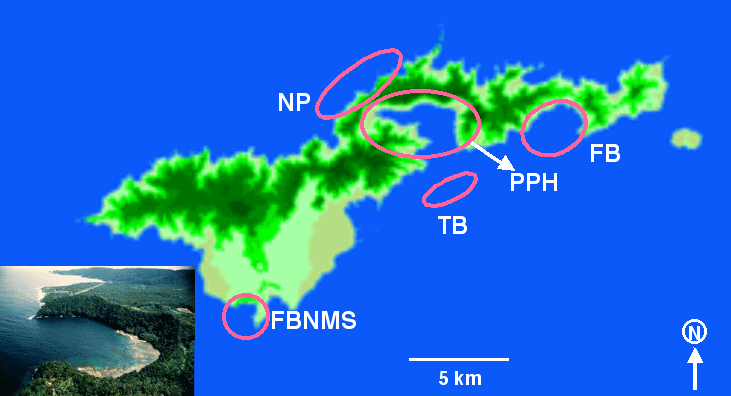
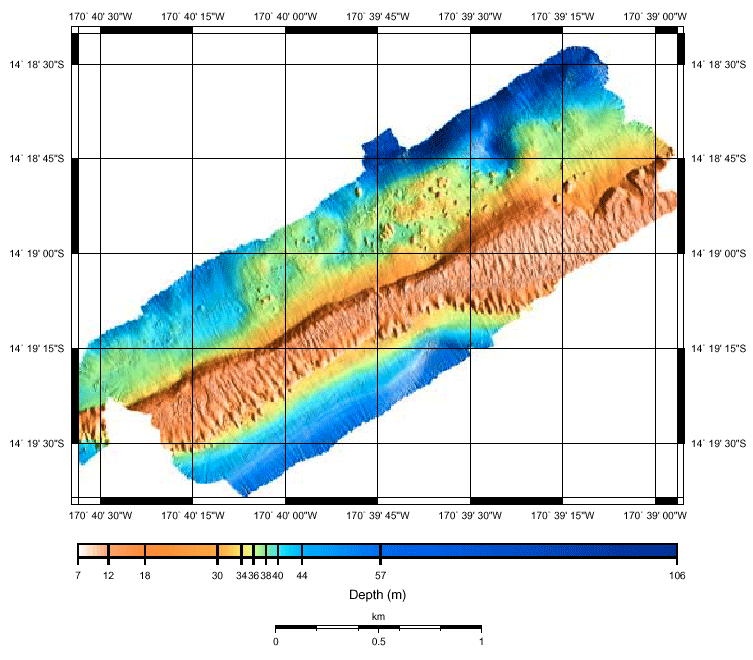
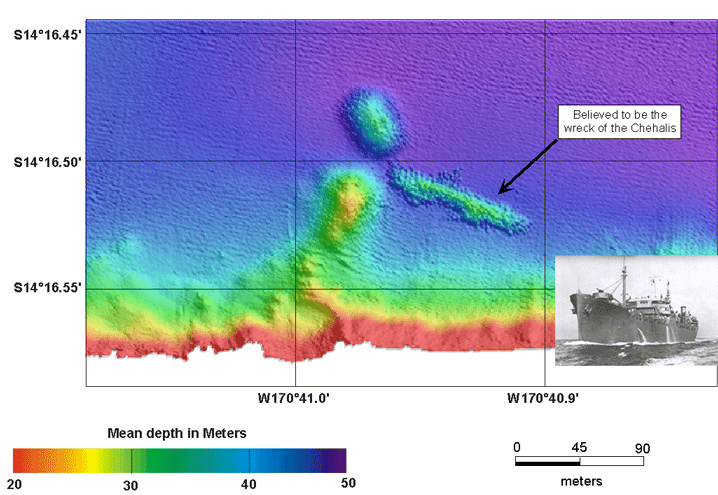
Bathymetric grids were then converted with ArcGMT, a public-domain suite of tools for converting GMT-style grids to Arc format. These bathymetric grids constituted the base layers for the FBNMS GIS (Wright et al., 2002), which also included an initial compilation of terrestrial data layers, including a 10-m digital elevation model of Tutuila, various digital line graph and digital raster graphics files, shapefiles, coverages, and grids, all obtained from the National Park Service, the USGS, the Digital Chart of the World, and other sources.
In order to make all data sets in the FBNMS GIS accessible, not only to the sanctuary staff and their collaborators in American Samoa, but to collaborators throughout Oceania and the U.S., a web clearinghouse was built ((dusk.geo.orst.edu/djl/samoa), providing links to all of the GIS data and metadata, and to bathymetric grids in GMT format for non-GIS users, various maps, photographic images, and graphics. All GIS data are provided as ArcInfo export interchange files (i.e., *.e00 files), which may be imported into ArcInfo, ArcView, or ArcExplorer.
"Ground-truthing" of bathymetric surveys with photography and videography will be an ongoing endeavor. For example, the new bathymetry of the FBNMS helped to guide the location of a deep-diving mission to the sanctuary on May 16, 2001 (Figure 4). University of Hawaii researcher Richard Pyle used rebreather technology to work underwater for over 3.5 hours (a block of time significantly longer than traditional SCUBA), and collected videotape of coral reef biota and habitats up to a maximum depth of 113 m. Although the diving mission was cut short by poor weather, twelve completely new species of fish were observed in the bay, including seventeen species that had never before been observed in American Samoa, and several species that were previously unknown to the waters of Fagatele Bay.
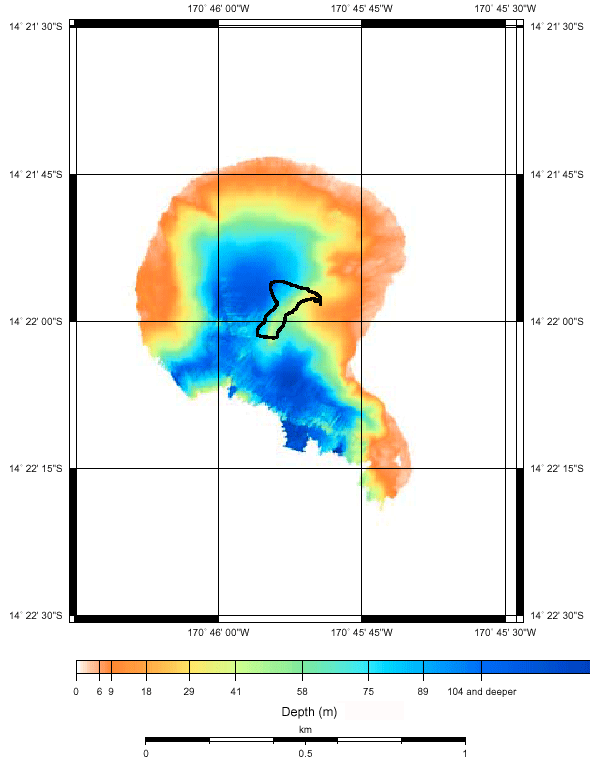
Datum and Projection Issues
Although a fair amount of terrestrial GIS data exists for the
territory, two continuing challenges have been the lack of metadata (addressed partly by the
Pacific Islands GIS initiative) and the difficulties in converting data between datums and
projection systems. A recent assessement by the user group of legacy data available
both locally and from Federal agencies revealed several problems, not only with the underlying
USGS spatial data reference framework but for many of the existing data sets. Many of
these problems are tied to an antiquated local datum known as the American Samoa Datum of 1962
(ASD62), which has been in use by the territorial government for several years. To diagnose
the extent and magnitude of the problem, a team from the NOAA National Geodetic Survey traveled
to American Samoa in August 2001, at which time they established the American Samoa
continuously operating reference station (CORS) on Tutuila to provide GPS carrier
phase and code range measurements and reoccupied the survey benchmarks that
were established in 1962. The territory now has very accurate geodetic survey information,
which is crucial for shifting antiquated spatial data from ASD62 to the North American Datum
of 1983 (NAD83) or the World Global System of 1984 (WGS84). The user group has developed
accurate methodologies for converting data from one datum to another (see projection document at
dusk.geo.orst.edu/djl/samoa, and
seeks to ensure that the information is shared between the local government, the federal agencies,
the private sector, and the communty college, and that new transformation algorithms for
this remote region of the Pacific will be incorporated into future revisions of Esri software
(i.e, University of Hawaii ShapeNADCON extension into ArcGIS 8 and 9).
In March of 2002 SSE led a 1-week SCUBA diving, photography,
fish count and public outreach mission to American Samoa. A team
consisting of Sylvia Earle (SSE), Kip Evans (SSE), Gale Mead (SSE),
Brian Donahue (USF), Laddie Akins (Reef Environmental Education
Foundation, REEF), and Nancy Daschbach, made 60 dives were to the
sanctuary and several other site around Tutuila, including an extensive
collection of underwater video and still images. Species observed and
documented included 30-50 species of corals, 4 different shark species,
over 200 fish species, and 20 invertebrate species. It is hoped that future
activities may be georeferenced for incorporation into GIS (i.e., more ground-truth).
Another activity that took place during the SSE mission was a 1-day multibeam
bathymetric mapping cruise aboard the R/V Revelle that, along with other
multibeam data mined from archives at the Scripps Institution of Oceanography, enabled
complete coverage of the mid- to deeper water flanks of Tutuila (Figure 5).
These new data will supplement the aforementioned shallow water surveys that were
incorporated into the FBNMS GIS in 2001. During the Revelle cruise, the entire north
flank of Tutuila and several deepwater multibeam data gaps along the southern flank were
mapped with the Kongsberg-Simrad hull-mounted EM120 system, revealing at least 6 new volcanoes
off of the northern flank, as well as the shape of banks along the south flank (Figure 6). Many
of these banks are inaccurately located on nautical charts and have never been fully mapped with
multibeam bathymetry.
Bathymetry data are still being post-processed, and final maps and GIS grids will be incorporated
into the FBNMS and made available on the web in late 2002.
SSE Mission
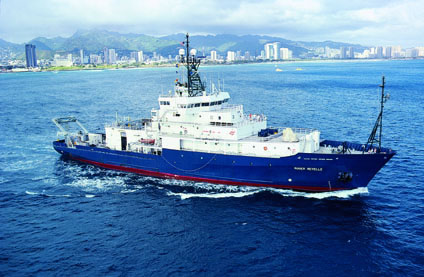
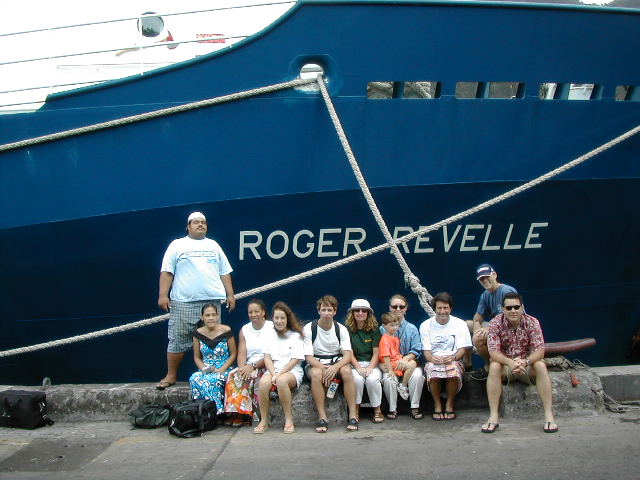
Figure 5. (top) Photo (courtesty of Scripps Instituion of Oceanography) of the 273-foot
R/V Roger Revelle used for the deepwater multibeam bathymetric survey around
Tutuila in March 2002. (bottom). Shipboard science party (except for the
little dude on his mom's lab) for the Tutuila bathymetric survey.
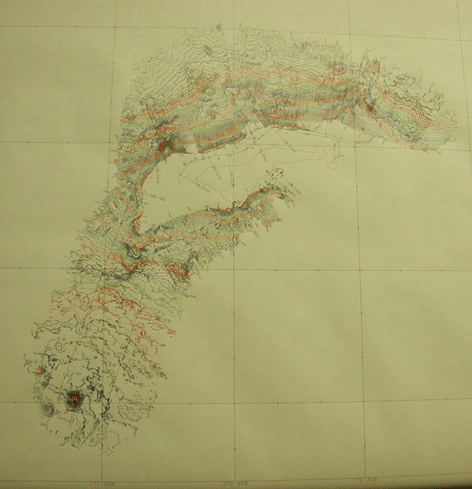
Figure 6. Photograph of raw multibeam bathymetry as it was being plotted in near realtime
aboard the Roger Revelle, merely to show extent of data collection during the 1-day survey that
circumnavigated Tutuila (photo by A. Graves).
Ongoing Initiatives
Additional shallow-water surveys are planned for December, 2002. In addition
to bathymetry, what will also be important for these surveys is the gathering
of backscatter imagery (representing the strength of the return signal rather
than just the traveltime), so that seafloor classification and habitat maps may
be prepared for depths of 30 m and greater. These will be integrated with
high-resolution 1- and 4-m IKONOS satellite imagery recently obtained from NOAA through
the Coral Reef Task Force Initiative. These maps will be the basis for ongoing
studies in the sanctuary and the park that will include selection of sites for
habitat class designation and protection (e.g., no-take marine protected areas), development
of sanctuary program monitoring protocols, and developing a general
understanding species composition and abundance.
Other ongoing initiatives include:
It has been very encouraging to witness the explosion of GIS activity in American Samoa, and this review has in no way been exhaustive. The concept of a "territory-wide" GIS for American Samoa is still developing, and in its current decentralized state, even with the formulation of a user group, a continual challenge will be to get data into the hands of resource managers and community activists, along with the tools and understanding of their usage that will allow them to use the data for effective decision-making. And how to do this while preventing duplication of efforts and services, and avoiding competition for the small number of highly-trained GIS personnel in the territory? One approach may be to take advantage of a student labor pool, both on and off-island, especially via a mentorship or apprenticeship program, supported by academic credits and training. The FBNMS has already initiated this, having provided travel support for OSU students to help with mapping and GIS coordination on Tutuila. Indeed, it has been argued by Oberlin (1996) that "the infrastructure most needed to support the information era is financial, social, and political, not technical."
Many thanks to Nancy Daschbach, manager of the Fagatele Bay National Marine Sanctuary with
whom the author originally made contact in order to start a wide range of collaborations.
Brian Donahue and Dave Naar of the University of South Florida Center for Coastal Ocean Mapping
have provided excellent multibeam mapping and data processing support. Ken Crouse of
OSU Geosciences is thanked for tireless computer technical support in rebuilding GIS files
and software in American Samoa during the summer of 2001. Mark Hayward of American
Samoa Government Department of Commerce and Allison Graves of Nuna Technologies and the
National Park of American Samoa have been invaluable in providing data and GIS assistance,
and are thanked also for fruitful discussions. Allison and Kevin Cronk, the NOAA Pacific
Island GIS intern for American Samoa, have worked tireless on procedures for converting from
American Samoa 1962 Datum, stateplane coordinates to North American Datum, UTM coordinates.
Cindy Fowler and Lori Cary-Kothera are thanked for their leadership of the Pacific Island
GIS intern program for American Samoa. Jennifer Aicher, Dave Kulberg, Champion Matu'u, and
Florence Lutu (American Samoa Community College), Kevin Cronk (American Samoa Government), and
Allison Graves and Stassia Samuels (National Park of American Samoa) are thanked for excellent
watchstanding at sea. And finally, Tony Beecham of the American Samoa Department of
Marine and Wildlife Resources is thanked for general support and good humor. The author was
supported by National Science Foundation (NSF) grant OCE/EHR-0074635, with additional travel funds
provided by the Fagatele Bay National Marine Sanctuary. Supplemental ship time for the
R/V Roger Revelle in order to complete the deepwater multibeam survey around Tutuila was funded
by grants NSF-OCE-0002312 to D. Naar, NOAA-408BNC101000 to D. Wright, and NSF-OCE-0074635
to D. Wright.
Anderson, C.L. (ed.), 1999. U.S. All Islands Coral Reef Initiative Strategy: Workshop Report
of the University of Hawaii Social Science Research Institute and the Pacific Basin Development
Council with the US All Islands Coral Reef Initiative Coordinating Committee, Representing the
Territory of American Samoa, the Commonwealth of the Northern Mariana Islands, the State of
Hawaii, the Territory of Guam, the Commonwealth of Puerto Rico, and the Territory of the U.S.
Virgin Islands, Honolulu, HI, University of Hawaii, online at www.hawaii.edu/ssri/Is_CRI.html
Oberlin, J.L., 1996. The financial mythology of information technology: Developing a new game plan,
CAUSE/EFFECT (now EDUCAUSE Quaterly ), 19(1), 21-29, online at www.educause.edu/ir/library/text/CEM9616.txt.
Smith, W.H.F. and D.T. Sandwell, 1997. Global seafloor topography from satellite altimetry,
Science, 277:1957-1962.
U.S. Coral Reef Task Force, 2000. National Action Plan for Coral Reef Conservation,
Washington, DC, U.S. Department of the Interior, online at CoralReef.gov/doc.cfm.
Wright, D.J., B.T. Donahue, and D.F. Naar, 2002. Seafloor mapping and GIS coordination at
America's remotest national marine sanctuary (American Samoa), in Wright, D.J. (ed.),
Undersea with GIS, Redlands, CA, Esri Press, 33-63.
Acknowledgments
References
Dawn J. Wright
Associate Professor
Department of Geosciences
104 Wilkinson Hall
Oregon State University
Corvallis, OR 97331-5506
Telephone: 541-737-1229
Fax: 541-737-1200
Email: dawn@dusk.geo.orst.edu

Panoramic digital photo mosaic from aboard the RV Revelle by Stassia Samuels, National
Park of American Samoa, March 2002